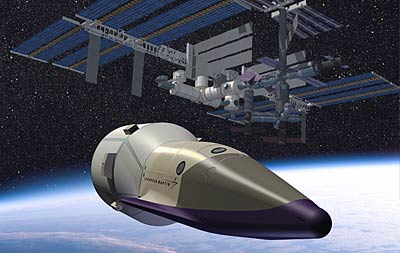What do we do with the ISS?by Taylor Dinerman
|
| For now the ISS fulfills two important goals: it provides a laboratory to test technologies and processes needed when astronauts move out beyond low Earth orbit, and to prove to the international partners that the US will keep its promises. |
The big question for the next NASA administrator will be whether he going to reverse the decision to delete the ISS service role from the Crew Exploration Vehicle’s mission. The CEV is supposed to be the multipurpose crew module that will carry America’s future generation of explorers to the Moon and perhaps eventually to Mars. According to the February 2004 Vision document, “The Crew Exploration Vehicle might also supplement international partner crew transport systems to the Space Station.” Apparently the word “might” has now been interpreted to mean “will not”.
The CEV was sold at least partly on the basis that it would replace the planned Orbital Space Plane (OSP), which was supposed to be a true multipurpose manned spacecraft. The OSP was to begin carrying crews back and forth from the ISS in 2012 and eventually become the primary way for US astronauts to travel between ISS to Earth, while the shuttle would be reserved for special ISS related missions. The Columbia disaster changed all that.
What has also changed is the way the ISS is regarded by NASA and the policymakers in the White House. For now the ISS fulfills two important goals: first it provides a laboratory where the US can, over time, test technologies and processes that will be needed when astronauts move out beyond low Earth orbit. The other important function is to prove to the international partners that the US will keep its promises. The US has enough problems with the Europeans and the Russians right now, so the feeling in Washington seems to be, “let’s just commit ourselves to finish building the thing and we’ll figure out what to do with it later.”
While this may be typical of the way things happen inside the US Government it leaves the Europeans and the other partners thoroughly puzzled. Is there really no plan for the $100-billion “world-class” orbiting laboratory other than the few long-term exploration oriented developments that are currently in the works? It seems that NASA has not been able to develop a plan that can realistically fit post-2010 or 2014 ISS operations into its current budget plan.
After the shuttle is retired NASA will have to spend every dime it can muster either on human-rating one or more of the heavy launch EELVs, probably the Delta 4, or on a shuttle-derived system. Perfecting the CEV after its first unmanned prototype flies in 2008 will also eat up the budget and will leave little, if any, room for ISS operations. What is worse from a budget planner’s standpoint is that in order to have any credibility on Capitol Hill they will have to put very large program reserves into every element of CEV development.
| Will the US be able to find a commercially viable, human-rated, private sector alternative to the shuttle, within the required timeframe? This is highly doubtful. |
Admiral Steidle knows that getting the so-called “Spiral 1” CEV into operation is the essential foundation for sustainability of the whole Vision for Space Exploration. Unless the hardware is robust and can be easily integrated with a variety of add-ons for lunar operations, then the whole edifice will crumble. This fact leads to the conclusion that NASA is probably ready to sacrifice many of its other programs, for example the Hubble, in order to make sure that the CEV gets off to a good start.
This may be reasonable enough, but it leaves the question of the ISS future control up in the air. Will the station become Russian by default? Certainly, if the Soyuz is the only way up and back, then the Russians will of necessity control access: all decisions on crew composition and on operations will be made in Moscow. Neither the Europeans nor the Japanese will have much say, if any, as to what happens on the ISS. Will they have much interest in being distinctly junior partners with Russia under these circumstances?
Will the US be able to find a commercially-viable, human-rated, private sector alternative to the shuttle, within the required timeframe? This is highly doubtful: though Robert Bigelow’s America’s Space Prize might produce a suitable vehicle, no one should count on such an outcome. Another possibility is that whoever is developing the NASA CEV might decide to build a privately-financed, quick and dirty version of this manned spacecraft. Such a vehicle and its launch system would lack all the features of the fully-developed Spiral 1 system, but it might be barely acceptable as an alternative to the Soyuz or its successor, the Clipper.
In any case the Congress will be asking the new administrator some tough questions. NASA’s long-range planning staff had better start working on some answers. It is not enough just to commit to assembling the ISS to the full 2010 configuration: they will have to come up with a credible plan for what they hope to accomplish up there after it is built. Otherwise, the question arises: why finish it at all?
